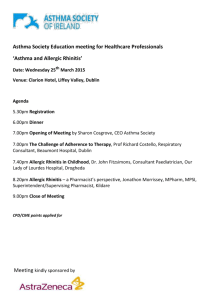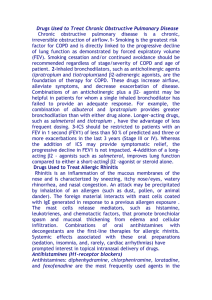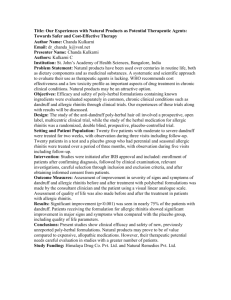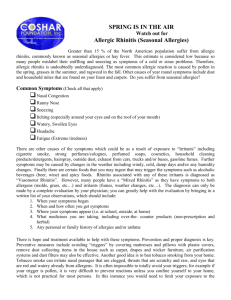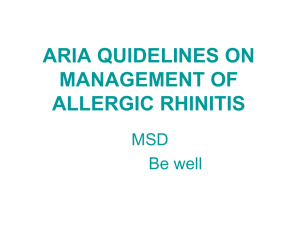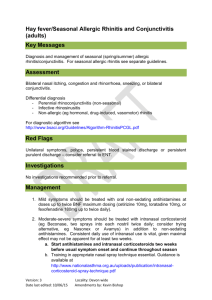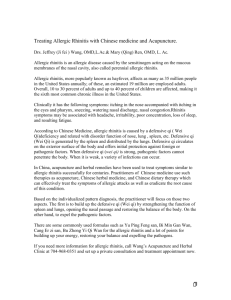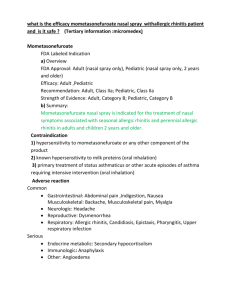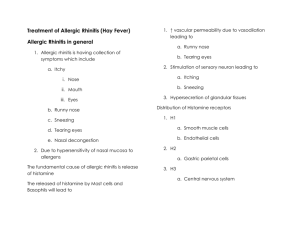Allergic Rhinitis Summary: Definition, Diagnosis & Management
advertisement
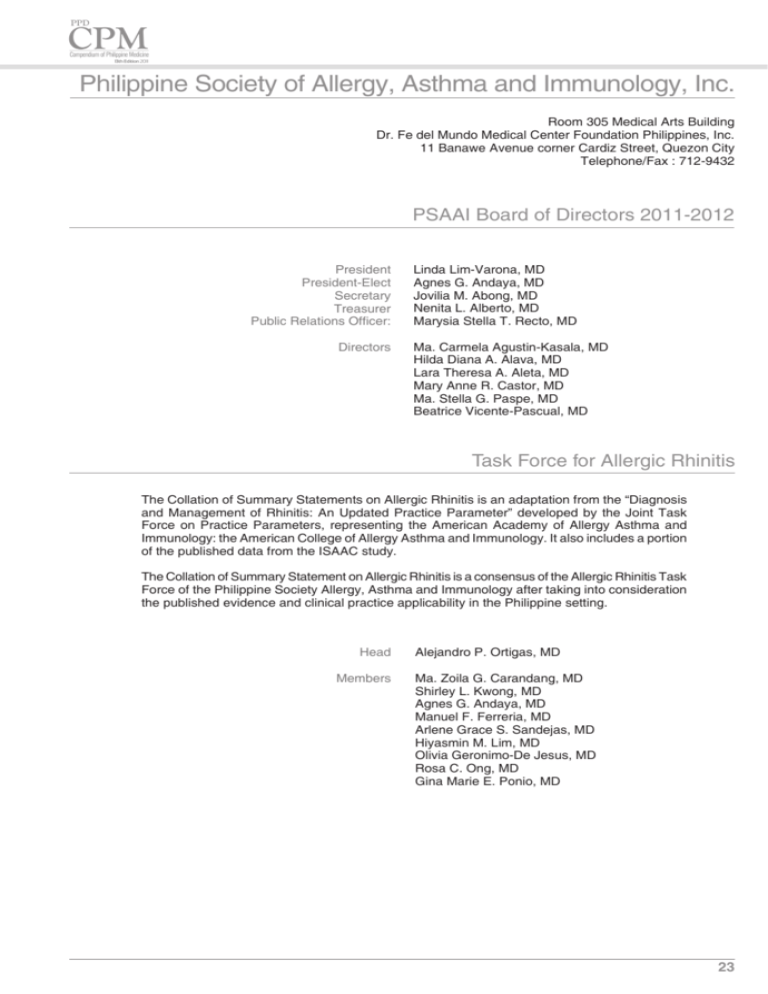
Allergic Rhinitis Philippine Society of Allergy, Asthma and Immunology, Inc. Room 305 Medical Arts Building Dr. Fe del Mundo Medical Center Foundation Philippines, Inc. 11 Banawe Avenue corner Cardiz Street, Quezon City Telephone/Fax : 712-9432 PSAAI Board of Directors 2011-2012 President President-Elect Secretary Treasurer Public Relations Officer: Directors Linda Lim-Varona, MD Agnes G. Andaya, MD Jovilia M. Abong, MD Nenita L. Alberto, MD Marysia Stella T. Recto, MD Ma. Carmela Agustin-Kasala, MD Hilda Diana A. Alava, MD Lara Theresa A. Aleta, MD Mary Anne R. Castor, MD Ma. Stella G. Paspe, MD Beatrice Vicente-Pascual, MD Task Force for Allergic Rhinitis The Collation of Summary Statements on Allergic Rhinitis is an adaptation from the “Diagnosis and Management of Rhinitis: An Updated Practice Parameter” developed by the Joint Task Force on Practice Parameters, representing the American Academy of Allergy Asthma and Immunology: the American College of Allergy Asthma and Immunology. It also includes a portion of the published data from the ISAAC study. The Collation of Summary Statement on Allergic Rhinitis is a consensus of the Allergic Rhinitis Task Force of the Philippine Society Allergy, Asthma and Immunology after taking into consideration the published evidence and clinical practice applicability in the Philippine setting. Head Members Alejandro P. Ortigas, MD Ma. Zoila G. Carandang, MD Shirley L. Kwong, MD Agnes G. Andaya, MD Manuel F. Ferreria, MD Arlene Grace S. Sandejas, MD Hiyasmin M. Lim, MD Olivia Geronimo-De Jesus, MD Rosa C. Ong, MD Gina Marie E. Ponio, MD www.TheFilipinoDoctor.com l Sign up and open your clinic to the world. 23 Allergic Rhinitis Collation of Summary Statements: Definition of allergic rhinitis 1. Allergic rhinitis is a classic example of Type I hypersensitivity, IgE mediated response. It may be characterized by early-phase and late phase responses. Each type of response is characterized by sneezing, congestion, rhinorrhea (anterior and posterior) and itching, but congestion predominates in the late phase. C Burden and epidemiology of allergic rhinitis 2. Published data on allergic rhinitis in the Philippines is limited to ISAAC study. In the US it affects 30-60 million people annually, including 10%-30% of adults and as many as 40 percent of children. C 3. Risk factors for allergic rhinitis include (1) family history of atopy, (2) serum IgE >100 IU/ml before age 6 years, (3) higher socioeconomic class, and (4) presence of a positive allergy skin prick test (SPT). C 4. The influence of early childhood exposure to infect­ ions, animals and secondary tobacco smoke on the development on the development of atopy and allergic rhinitis is still not clear. C 5. Aeroallergen sensitization may occur within the first 2 years of life. C 6. The cost of treating allergic rhinitis and indirect cost related to loss of workplace productivity resulting from disease are substantial. It is also a significant cause of lost of work and school days. C Pathogenesis 7. The symptoms of allergic rhinitis result from a complex allergen-driven mucosal inflammation caused by interplay between resident and infiltrating cells and a number of vasoactive and proinflammatory mediators, including cytokines. Sensory nerve activation, plasma leakage, and congestion of venous sinusoids also contribute. C Seasonal and perennial allergic rhinitis 8. Seasonal allergic rhinitis is caused by an IgE-mediated reaction to seasonal allergens. Symptoms may occur only during specific seasons. The length of seasonal exposure to these allergens is dependent on geographic location and climatic conditions. C 9. Perennial allergic rhinitis is caused by an IgE-mediated reaction to perennial environmental aeroallergens. Symptoms may occur with or without seasonal exacerbations. Perennial environmental aeroallergens include dust mites, molds, animal allergens, or certain occupational allergens, as well as pollen in areas where pollen is prevalent perennially. C 10. Episodic allergic rhinitis denotes allergic nasal symptoms elicited by sporadic exposures to inhalant aeroallergens. D Severity 11. The severity of allergic rhinitis ranges from mild and intermittent to seriously debilitating, or mild, mode­ rate- severe. D 12. Although there is no generally accepted method of grading the severity of allergic rhinitis, the clinician may want to consider a graphic rating scale. D Associated allergic conjunctivitis 13. Allergic rhinitis is often accompanied by symptoms 24 of allergic conjunctivitis. C 14. Many treatments used for allergic rhinitis can benefit associated symptoms of allergic conjunctivitis, and a variety of topical ophthalmic agents is useful for specific treatment of associated ocular symptoms. A 15. Intranasal steroids, oral antihistamines, and intranasal antihistamines have similar effectiveness in relieving eye symptoms associated with rhinitis. A Differential diagnosis of allergic rhinitis 16. Non-allergic rhinitis is characterized by periodic or perennial symptoms of rhinitis that are not a result of IgE-dependent events. Examples are infectious rhinitis, vasomotor rhinitis, non-allergic rhinitis with eosinophilia syndrome (NARES), food & druginduced rhinitis, occupational rhinitis, hormonal rhinitis, atrophic rhinitis, nasal polyps, anatomic abnormalities, cerebrospinal fluid rhinorrhea and ciliary dysfunction. C Evaluation and diagnostic studies History 17. An effective evaluation of the patient with allergic rhinitis often includes the following: a determination of the pattern, chronicity and seasonality of nasal and related symptoms (or lack thereof); response to medications; presence of coexisting conditions; occupational exposure; and a detailed environmental history and identification of precipitating factors. D 18. Evaluation of allergic rhinitis therapy should include assessment of quality of life (QOL). C Physical Examination 19. A physical examination of all organ systems potentially affected by allergies with emphasis on the upper respiratory tract should pe performed in patients with a history of allergic rhinitis. The nasal examination supports but does not definitely establish the diagnosis of allergic rhinitis. D Testing for specific IgE antibody Skin testing 20. Determination of specific IgE, preferably by skin testing, is indicated to provide evidence of an allergic basis for the patient’s symptoms, or to assess the sensitivity to a specific allergen for avoidance measures and/or allergen immunotherapy. B 21. Skin tests are the preferred tests for the diagnosis of IgE- mediated sensitivity. The number of skin tests and the allergens selected for skin testing should be determined on the basis of the patient’s age, history, environment, and living situation, such as area of the country, occupation and activities. D In vitro assays for specific IgE 22. The precise sensitivity of specific IgE immunoassays compared with skin prick/puncture tests is approximately 70% to 75%. Immunoassays have similar sensitivity to skin tests in identifying those patients with nasal symptoms elicited after natural or controlled allergen challenge tests. C 23. The interpretation of IgE is best done by an allergyimmunology specialist. It may be confounded by variables such as potency of allergens bound to solid support systems, cross-reactive proteins and Allergic Rhinitis glycol-epitopes, specific IgG antibodies in the test serum and high total IgE. D Special diagnostic techniques 24. In selected cases, special techniques may be useful in evaluating patients presenting with allergic rhinitis symptoms and its associated diseases: fiberoptic nasal endoscopy and/or rhinomanometry, nasal smears for eosinophils, saccharin test for mucociliary clearance, nasal biopsy, measurement of total IgE and IgG subclasses, B-2-transferrin, sweat test, sinus computed tomography (CT), evaluation for obstructive sleep apnea, pulmonary function tests. B 25. There is no evidence that the following procedures have diagnostic validity for allergic rhinitis: cytotoxic tests, provocation-neutralization, electrodermal testing, applied kinesiology, iridology and hair analysis. B Management of Allergic Rhinitis (See Table 1 in Appendix for Sample Action Plan) Environmental control measures play a significant role in controlling allergic rhinitis. 26. The most common allergic triggers for rhinitis include pollens, fungi, dust mites, furry animals, and insect emanations. B 27. The types of pollen responsible for rhinitis symptoms vary widely with locale, climate, and introduced plantings. B 28. Highly pollen-allergic individuals should limit exposure to the outdoors. Ideally, pollen counts should be available in the locale. B 29. Fungi are ubiquitous organisms, many of which produce clinically important allergens. B 30. Reduction of indoor fungal exposure involves removal of moisture sources, replacement of contamination materials, and the use of dilute bleach solutions on nonporous surfaces. D 31. Clinically effective dust mite avoidance requires a combination of dust mite covers for bedding, high efficiency particulate air (HEPA) vacuuming of carpeting, and the use of acaricides. B 32. Avoidance is the most effective way to manage animal sensitivity. D 33. Cockroaches are a significant cause of nasal allergy. C 34. The best preventive measure for allergic rhinitis is avoidance. B Pharmacologic therapy Oral antihistamines 35. Second-generation antihistamines are generally preferred over first-generation antihistamines for the treatment of allergic rhinitis. First-generation antihistamines have significant potential to cause sedation, performance impairment, and anticholinergic effects. Although occasionally advantageous (e.g., sleep induction when taken at bedtime or a reduction in rhinorrhea), these properties are usually undesirable and are potentially dangerous. Second-generation antihistamines have less or no tendency to cause these effects. B 36. Before prescribing or recommending a first-gene­ ration antihistamine, the physician should ensure that the patient understands both the potential for adverse effects and the availability of alternative antihistamines with a lower likelihood of adverse effects. D 37. There are important differences among the secondgeneration antihistamines in regard to their sedative properties: fexofenadine, loratadine, and desloratadine do not cause sedation at recommended doses; loratadine and desloratadine may cause sedation at doses exceeding the recommended dose; cetirizine and intranasal azelastine may cause sedation at recommended doses. A 38. Among the newer, nonsedating antihistamines, no single agent have been conclusively found to achieve superior overall response rates. C Intranasal antihistamines 39. Intranasal antihistamines may be considered for use as first-line treatment for allergic rhinitis. A 40. Intranasal antihistamines are efficacious and equal to or superior to oral second-generation antihistamines for treatment of seasonal allergic rhinitis. A 41. Because systemic absorption occurs, currently available intranasal antihistamines have been associated with sedation and can inhibit skin test reactions. A 42. Intranasal antihistamines have been associated with a clinically significant effect on nasal congestion. A 43. Intranasal antihistamines are generally less effect­ ive than intranasal corticosteroids for treatment of allergic rhinitis. A Oral and topical decongestants 44. Oral decongestants, such as pseudoephedrine and phenylephrine, are a-adrenergic agonists that can reduce nasal congestion but can result in side effects such as insomnia, irritability, and palpitations. A 45. Oral and topical decongestant agents should be used with caution in older adults and young children, and in patients of any age who have a history of cardiac arrhythmia, angina pectoris, cerebrovascular disease, hypertension, bladder neck obstruction, glaucoma, or hyperthyroidism. C 46. Topical decongestants can be considered for shortterm and possibly for intermittent or episodic therapy of nasal congestion, but are inappropriate for regular daily use because of the risk for the development of rhinitis medicamentosa, which may occur within the third and fourth day. C Over-the-counter cough and cold medications for young children 47. The efficacy of cold and cough medications for symptomatic treatment of upper respiratory tract infections has not been established for children younger than 6 years. Because of the potential toxicity of these medications, the use of these over-the-counter (OTC) drugs generally should be avoided in all children below 6 years of age. A INTRANASAL CORTICOSTEROIDS 48. Intranasal corticosteroids are the most effective medication class for controlling symptoms of allergic rhinitis. A 49. In most studies, intranasal corticosteroids have been shown to be more effective than the combined use of an antihistamine and leukotriene (LT) antagonist in the treatment of seasonal allergic rhinitis. A 50. Intranasal corticosteroids may provide significant relief of symptoms of seasonal allergic rhinitis www.TheFilipinoDoctor.com l Sign up and open your clinic to the world. 25 Allergic Rhinitis when used not only on a regular basis but also on as needed basis. B However as needed use may not be as effective as continuous use of intranasal corticosteroids. 51. When comparing the available intranasal corticosteroids, the overall clinical response does not appear to vary significantly between products irrespective of the differences in topical potency, lipid solubility and binding affinity. C 52. Intranasal corticosteroids when given in recommended doses are not generally associated with clinically significant systemic side effects. A 53. Although local side effects are typically minimal with the use of intranasal corticosteroids, nasal irritation and bleeding may occur. Nasal septal defect is rarely reported. B Oral Corticosteroids 54. A short course (5-7 days) of oral corticosteroids may be appropriate for the treatment of very severe or intractable nasal symptoms or to treat nasal polyposis. However single administration of parenteral corticosteroids is discouraged and recurrent administration of parenteral corticosteroids is contraindicated because of potential for long term corticosteroid side effects. D Intranasal cromolyn 55. Intranasal cromolyn sodium is effective in some patients for prevention and treatment of allergic rhinitis and is associated with minimal side effects. It is less effective in most patients than corticosteroids and has not been adequately studied in comparison with LT antagonists and antihistamines. A Intranasal anticholinergics 56. Intranasal anticholinergics may effectively reduce rhinorrhea but have no effect on other nasal symptoms. Although side effects are minimal, dryness of the nasal membranes may occur. A 57. The concomitant use of ipratropium bromide nasal spray and an intranasal corticosteroid is more effective than administration of either drug alone in the treatment of rhinorrhea without any increased incidence of adverse effect. A Oral and LT agents 58. Oral anti LT agents alone or in combination with antihistamines have proven to be useful in the treatment of allergic rhinitis. A Omalimuzab 59. Omalimuzab has demonstrated efficacy in AR; however, it has US Food and Drug Administration (FDA) approval for use only in allergic rhinitis. A Nasal saline 60. There is evidence that topical saline is beneficial in the treatment of the symptoms of chronic rhinorrhea and rhinosinusitis when used as a sole modality or for adjunctive treatment. A Allergen immunotherapy 61. Allergen immunotherapy is effective for the treatment of allergic rhinitis. A 62. Allergen immunotherapy should be considered for patients with allergic rhinitis who have demonstrable evidence of specific IgE antibodies to clinically rele­ 26 vant allergens, and its use depends on the degree to which symptoms can be reduced by avoidance and medication, the amount and type of medication required to control symptoms, and the adverse ­effects of the medications. A 63. Allergen immunotherapy may prevent the development of new allergen sensitization ad reduce the risk for the future development of asthma in patients with allergic rhinitis. B Surgery 64. Although there is no surgical treatment for allergic rhinitis, surgery may be indicated in the management of comorbid conditions, such as nasal obstruct­ ion from severe nasal septal deviation or inferior turbinate hypertrophy, adenoidal hypertrophy, or refractory sinusitis and complications thereof. C Management decisions 65. Management and monitoring of “Allergic rhinitis” should be individualize and based on the spectrum, duration and severity of symptoms; physical examination findings; comorbidities; age of the patient; and patient preferences using both step-up and step-down approaches. C 66. Effective allergic rhinitis management requires the development of a physician/patient/family partnership, avoidance of environmental triggers, and the appropriate use of prescribed therapeutic interventions. C Education of patient and caretakers 67. Education is a key element in promoting adherence and optimizing treatment outcomes in allergic rhinitis. D Major comorbid conditions 68. Patients with allergic rhinitis are at increased risk for the development of asthma. A 69. Treatment of allergic rhinitis may improve asthma control in patients with co-existing allergic rhinitis and asthma. B 70. The cause-and-effect relationship of allergic rhinitis with recurrent otitis media and otitis media with effu­ sion (OME) is not yet clearly established. C Special Considerations Pregnancy 71. When selecting medications for treating rhinitis in pregnancy, the clinician might consider the FDA risk categories that are largely based on animal data and limited human studies. However, it is also beneficial to review human cohort and case-control studies as well as birth registry data before reaching a decision. C 72. The most critical time for concern about potential congenital malformation because of medication use is the first trimester, when organogenesis is occurring. D 73. A sufficient amount of human observational data has now been accumulated to demonstrate safety for second-generation as well as first-generation antihistamines. C 74. Oral decongestants should be avoided during the first trimester. Topical decongestants when used on a short – term basis may have a better safety profile than oral agents for first trimester use. C Allergic Rhinitis 75. Sodium cromolyn is a safe treatment for allergic rhinitis during pregnancy. C 76. Montelukast is a safe treatment for allergic rhinitis during pregnancy. C 77. Intranasal steroids may be used in the treatment of nasal symptoms during pregnancy because of their safety and efficacy profile. C 78. Immunotherapy for allergic rhinitis may be continued during pregnancy but without dose escalation. C Elderly Patients 79. Rhinitis in the elderly may be caused by types of rhinitis common in other age groups but may also be influenced by age related physiologic changes such as cholinergic hyperactivity, anatomic changes and medications taken for other medical conditions. C Athletes 80. Athletic performance can be affected by rhinorrhea and chronic or rebound nasal congestion. Rhinitis medication for the competitive athlete must be an International Olympic Committee (IOC) approved product and should be one that does not adversely affect performance. C Consultation with an Allergist 81. Allergist care improves patient outcomes; however, consultation/referral services are often underused. C 82. Consultation with an allergist should be considered for patients with rhinitis who have inadequately controlled symptoms, a reduced QOL and/or abi­ lity to function, adverse reactions to medications, a desire to identify the allergens to which they are sensitized and to receive advice on environmental control, or co-morbid conditions such as asthma and recurrent sinusitis, or when allergen immunotherapy is a consideration. C Referral Guidelines 1. Patients with allergic rhinitis with prolonged and severe disease with: a. Co-morbid conditions i.Asthma ii.Recurrent sinusitis iii.Nasal Polyps iv. Conjunctivitis b. Symptoms interfere with i. QOL (quality of life) ii. Ability to function c. Medications are i. Ineffective ii. Associated with adverse reactions iii. Unacceptable for chronic use by patient choice, such as cost or concern with long term side effects 2. Patients with allergic rhinitis, children and possibly adults, being considered for allergen immunotherapy as a means of preventing the progression of allergic disease. Learn to access drug info on your cellphone. Send PPD to 2600 for Globe/Smart/Sun users. 27 Allergic Rhinitis Appendix: Fig 1: Sample Action Plan for the Management of AR Table 1: Definition of levels of evidence as denoted by capital letters (U.S. Preventive Services Task Force*) Level A Level B Level C Level D Level I Good scientific evidence suggests that the benefits of the clinical service substantially outweigh the potential risks. Clinicians should discuss the service with eligible patients. At least fair scientific evidence suggests that the benefits of the clinical service outweigh the potential risks. Clinicians should discuss the service with eligible patients. At least fair scientific evidence suggests that there are benefits provided by the clinical service, but the balance between benefits and risks are too close for making general recommendations. Clinicians need not offer it unless there are individual considerations. At least fair scientific evidence suggests that the risks of the clinical service outweigh potential benefits. Clinicians should not routinely offer the service to asymptomatic patients. Scientific evidence is lacking, of poor quality, or conflicting, such that the risk versus benefit balance cannot be assessed. Clinicians should help patients understand the uncertainty surrounding the clinical service. *Adopted from http://www.uspreventiveservicestaskforce.org/3rduspstf/ratings.htm 28 Allergic Rhinitis Recommended Therapeutics The following index lists therapeutic classifications as recommended by the treatment guideline. For the prescriber's reference, available drugs are listed under each therapeutic class. For drug information, please refer to the Philippine Drug Directory System (PPD, PPD Pocket Version, PPD Text, PPD Tabs). Anti-leukotrienes Montelukast sodium Kastair Kastair EZ Tab Kastorion Leukast Montair Montemax Montiget Singulair Zafirlukast Accolate Anticholinergics Ipratropium bromide Atrovent Ipratropium bromide/Fenoterol Berodual Ipratropium bromide/Salbutamol Combivent Duavent Duavent Metered Dose Inhaler Pulmodual Tiotropium Spiriva Antihistamines Acrivastine Azelastine HCl Azela Nasal Spray Azelone Azep Cetirizine Aforvir Allerkid Allermed Alnix Antrazine Cetimin Cetyrol Drugmaker's Biotech Cetirizine HCl H-One Histamed Histazine Prixlae Recozin Rhinitrin Texzine Unizef Virlix Welcet Zetrix Zinex Zyrrigin Zyrtec Chlorphenamine maleate Antamin Barominic Drugmaker's Biotech Chlorphenamine Chlorphenoxamine HCl Systral Clemastine fumarate Marsthine Clemastine hydrogen fumarate Tavegyl Tavist Desloratadine Aerius Dimethindene maleate Diphenhydramine HCl Allerin AH Am-Europharma Diphenhydramine HCl Benadryl Drugmaker's Biotech Diphenhydramine Hizon Diphenhydramine Injection Nebrecon Diphenhyrdramine/ Phenylpropanolamine Disodium cromoglycate/ Benzalkonium Cl Vividrin Nasal Spray Ebastine Aleva Ebastine/Betamethasone Co-Aleva Fexofenadine Fenafex Fexet Fexoral Neofex Sensitin Telfast Hydroxyzine diHCl Drugmaker's Biotech Hydroxyzine Iterax Levocetirizine diHCl Xyzal Levocetirizine diHCl/ Montelukast Zykast Loratadine Allerta Claritin Lergicyl Loradex Lorange Lorano Lorat Loratyne Lordam Lorfast Lorid Onemin Toral Zantih Zylohist Loratadine/ Bethamethasone Claricort Loratadine/Phenylephrine Loraped Mebhydrolin napadisylate Mequitazine Primalan Olopatadine HCl Patanol Promethazine HCl Corticosteroids Betamethasone/ Chlorpheniramine maleate Betneton Betamethasone/ Dexchlorphenamine maleate Celestamine Dexamethasone Cordex-5 Decilone Dexacort Drenex Oradexon Fluticasone furoate Avamys Fluticasone propionate Flixotide Flixotide Aqueous Nasal Spray Nasoflo Fluticasone propionate/ Salmeterol xinafoate Salmeflo Seretide Prednisolone/ Chlorphenamine maleate Histacort Tablet Decongestants Brompheniramine maleate/ Phenylephrine HCl Dimetapp DMT Profaril Remedril Snizee Brompheniramine maleate/ Phenylpropanolamine Pediatapp Syrup/Oral Drops Camphor/Menthol/Eucalyptol Chlorphenamine maleate/ Dextromethorphan/Guaifenesin/ Phenylpropanolamine HCl Mucobron Forte Myracof-AF Chlorphenamine maleate/ Dextromethorphan/Guaifenesin/ Phenylpropanolamine HCl/ Paracetamol Dynatussin (capsule) Myracof-T Chlorphenamine maleate/ Guaifenesin/ Phenylpropanolamine Neo-Bromexan Chlorphenamine maleate/ Paracetamol/Phenylephrine Coldzep Decolgen Chlorpheniramine maleate/ Phenylephrine HCl Bronchofen Chlorphenamine maleate/ Phenylpropanolamine HCl Cynosal (drops) Nasathera CPM www.TheFilipinoDoctor.com l Sign up and open your clinic to the world. 29 Allergic Rhinitis Neozep Syrup (Oral Drops) Noxifen Chlorphenamine maleate/ Phenylpropanolamine HCl/ Paracetamol Bioflu Coldezent Cynosal (syrup) Nafarin-A Nagelin Nasagesic Neo-Bromexan Forte Neozep/Neozep Forte Norcolds Sinutab Extra Strength Diphenhydramine HCl/ Phenylpropanolamine HCl Guaifenesin/Chlorphenamine maleate Guaifenesin/Chlorphenamine maleate/Phenylpropanolamine Langex Guaifenesin/Chlorphenamine maleate/Sodium citrate/ Phenylpropanolamine Guaifenesin/ Oxeladine citrate/ Sodium citrate Altussan (syrup) Guaifenesin/ Oxeladine citrate/ Phenylpropanolamine/ Chlorpheniramine maleate Altussan (capsule) Guaifenesin/Chlorphenamine maleate/Sodium citrate/ Ammonium chloride Eurocof Guaifenesin/ Dextromethorphan Paracetamol/Phenylpropa­ nolamine/ Chlorphenamine maleate Colvan Mucotuss Guaifenesin/Dextromethorphan Paracetamol/Phenylpropa­ nolamine/Sodium citrate Dynatussin (syrup) Loratadine/ Pseudoephedrine sulfate Clarinase Phenylephrine/ Dextromethorphan/ Paracetamol Tuseran Forte Phenylephrine HCl/ Paracetamol No-Drowse Decolgen Non-Drowsy Neozep Phenylpropanolamine Disudrin Nasathera P Propadrin Phenylpropanolamine HCl/Chlor­ phenamine maleate Drinus (syrup) Noxifen Phenylpropanolamine/ Paracetamol Nasathera Phenylpropanolamine/ Paracetamol/ Dextromethorphan Decolsin Reformulated Phenylpropanolamine/Paracetamol/ Guaifenesin/Dextromethorphan/ Chlorphenamine maleate Phenylpropanolamine/ Paracetamol/Phenyltoloxamine Phenylpropanolamine/ 30 Phenylephrine/Brompheniramine maleate Drugmaker's Biotech Phenylpropanolamine + Phenylephrine + Brompheniramine Rhinotapp Sodium chloride Muconase Salinase Snif Nasal Preparations Azelastine Azep Budesonide Budecort Aqueoua Nasal Spray Disodium cromoglycate/ Benzalkonium chloride Vividrin Nasal Spray Ciclesonide Omnaris Fluticasone furoate Avamys Fluticasone propionate Flixotide Aqueous Nasal Spray Nasoflo Fusafungine Locabiotal 1% Mometasone furoate monohydrate Nasonex AQ Nasal Spray Oxymetazoline HCl Drixine Nasal Spray/Ped Drops Sodium chloride Muconase Salinase Snif Triamcinolone Actonaze Kenacort Tricin Cream Ultra filtrated and desalinised natural sea-water Physiomer Xylometazoline HCl Otrivin Mucokinetics/Expectorants Bromhexine/Chlorphenamine maleate Mucosform
